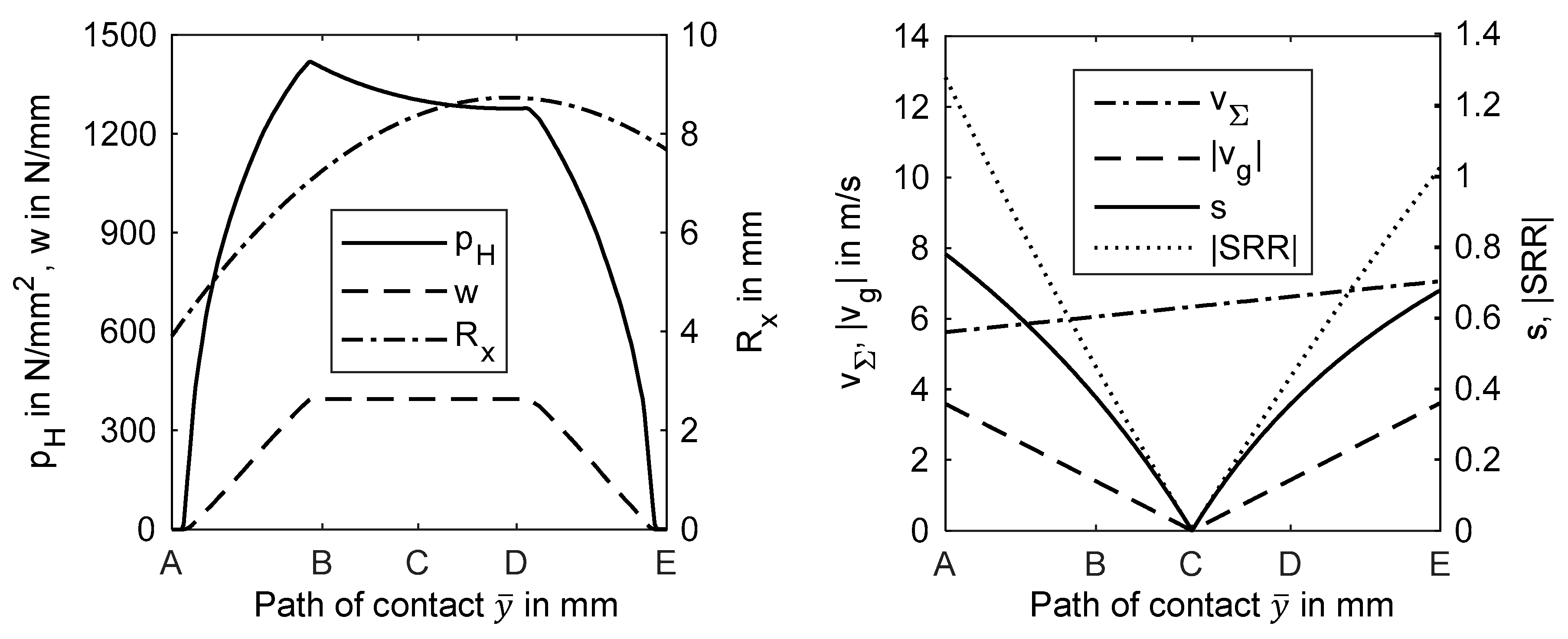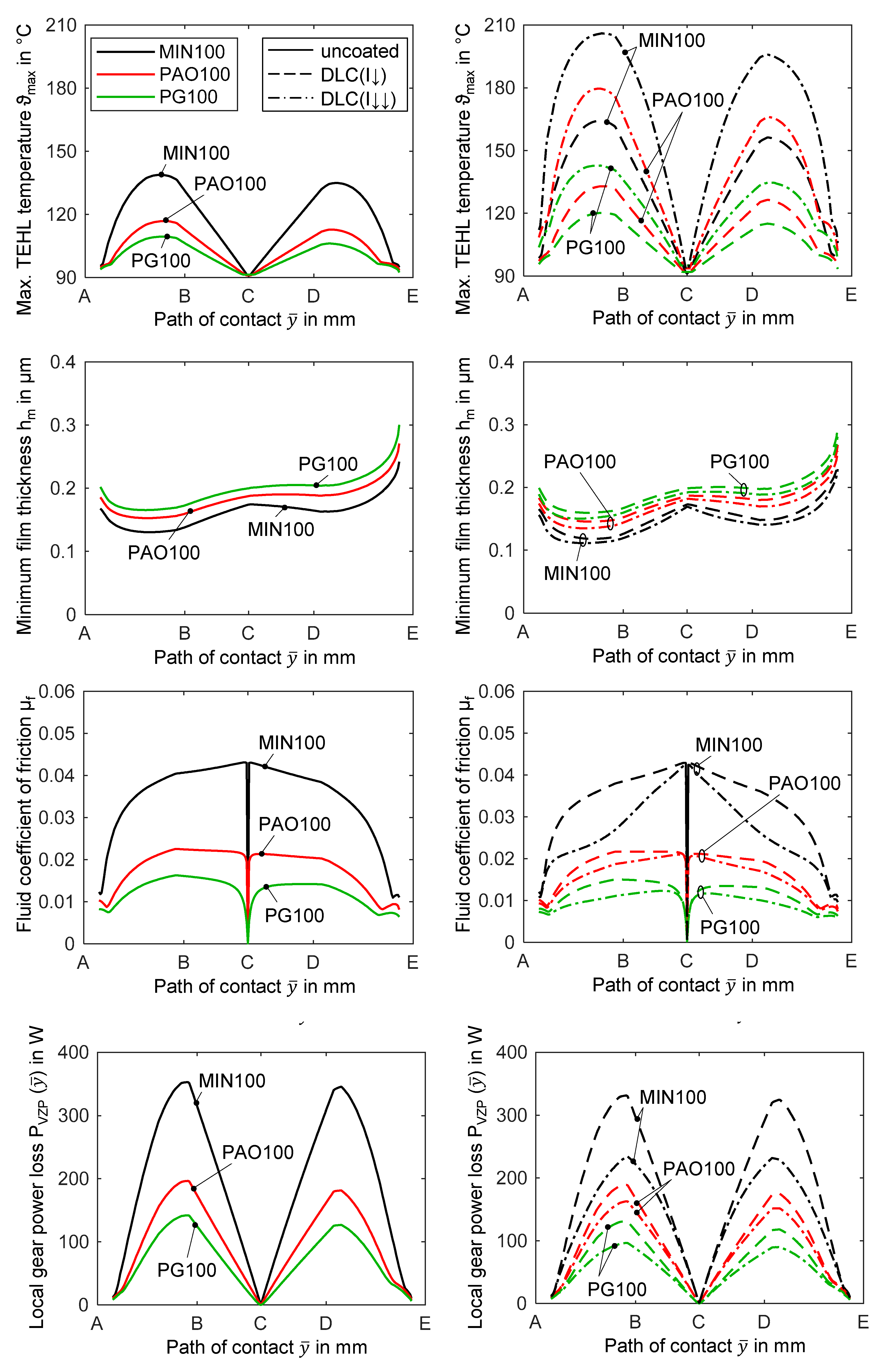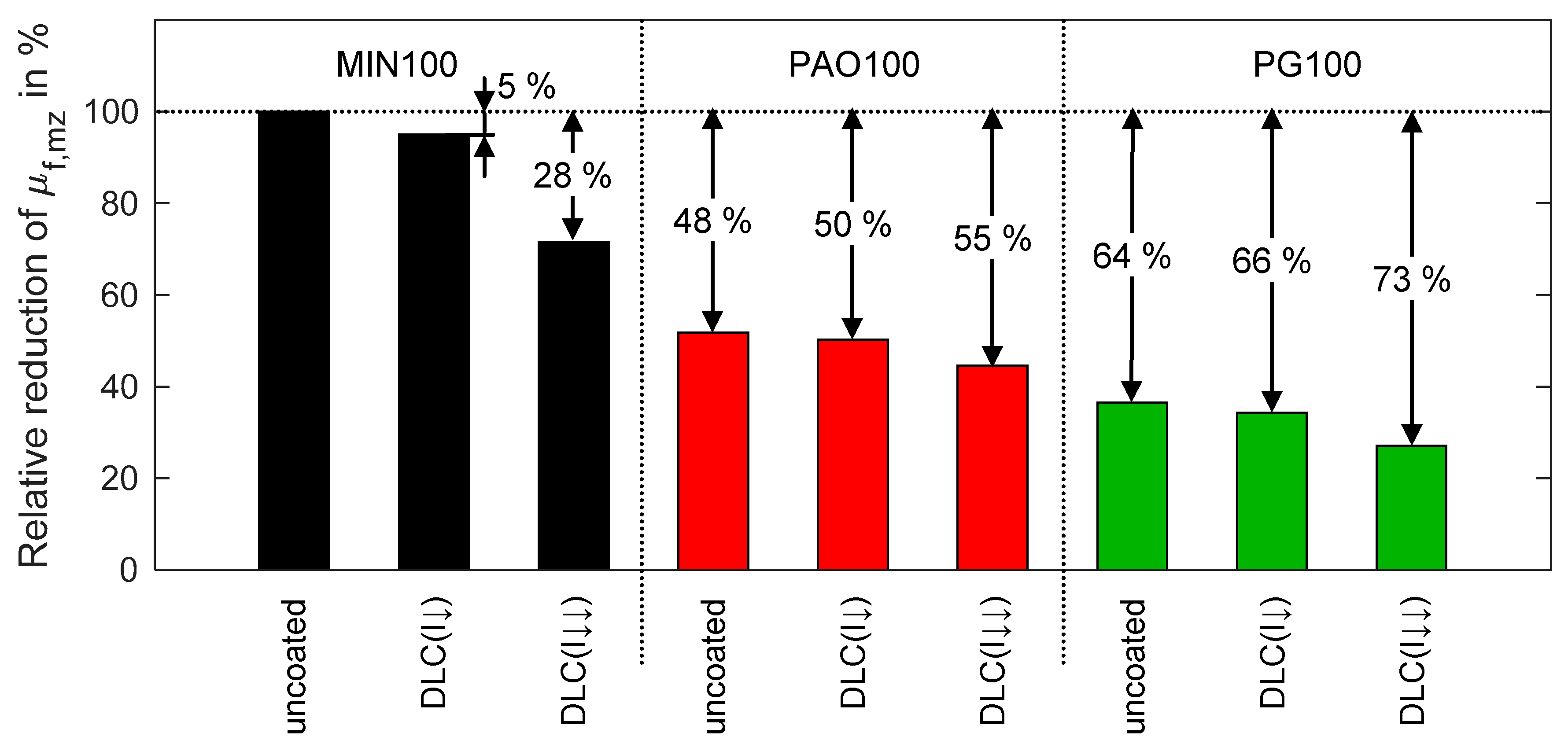TEHL Simulation on the Influence of Lubricants on the Frictional Losses of DLC Coated Gears †
Abstract
:1. Introduction
2. TEHL Simulation
2.1. Generalized Reynolds Equation
2.2. Contact Mechanics
2.3. Energy Conservation
2.4. Lubricant Properties
2.5. Numerical Procedure
3. Results and Discussion
3.1. TEHL Temperature along the Path of Contact
3.2. Minimum Film Thickness along the Path of Contact
3.3. Fluid Coefficient of Friction along the Path of Contact
3.4. Local Gear Power Loss along the Path of Contact
3.5. Mean Fluid Coefficient of Friction of Gears
4. Conclusions
Acknowledgments
Author Contributions
Conflicts of Interest
Nomenclature
| A | Begin of contact | Line load in | |
| Coefficients of lubricant Vogel temperature model | Film thickness length direction in | ||
| B | Begin of singular contact | Coordinate along the path of contact in | |
| C | Pitch point | Film thickness height direction in | |
| Compliance matrix | Pressure exponent of Roelands’ equation | ||
| Specific heat capacity in | |||
| D | End of singular contact | Pressure viscosity exponent in | |
| Coefficients of lubricant Bode density model | Coefficient of lubricant Bode density model in | ||
| E | End of contact | Deformation of the equivalent body in m | |
| Equivalent Young’s Modulus in | Strain tensor | ||
| Lubricant-specific parameters of | Dynamic viscosity in | ||
| Normal force in | Bulk temperature in | ||
| Lubricant film thickness in | Maximum TEHL temperature in | ||
| Constant parameter of film thickness in | Maximum TEHL temperature rise in | ||
| Minimum film thickness in | Thermal conductivity in | ||
| Effective contact length in width direction in | Equivalent Poisson’s ratio | ||
| Pressure in | Density in | ||
| Hertzian pressure in | Coefficient of the lubricant Bode density model in | ||
| Load-dependent gear power loss in | Shear stress in | ||
| Coefficient in the Roelands’ equation in | Limiting shear stress in | ||
| Radius of curvature in | Minimum limiting shear stress in | ||
| Deviation from the smooth profile in | Coefficient of friction | ||
| Slide-to-roll ratio | Mean coefficient of friction | ||
| Slip ratio | Kinematic viscosity in | ||
| Time in | |||
| Temperature in | 1 | Pinion | |
| Pinion torque in | 2 | Wheel | |
| Velocity in | f | Fluid | |
| Sliding velocity in | s | Substrate | |
| Pitch line velocity in | c | Coating | |
| Sum velocity in | |||
References
- Liu, H.; Jurkschat, T.; Lohner, T.; Stahl, K. Determination of Oil Distribution and Churning Power Loss of Gearboxes by Finite Volume CFD Method. Tribol. Int. 2017, 109, 346–354. [Google Scholar] [CrossRef]
- International Organization for Standardization. ISO TR 14179-2:2001-08: Gears—Thermal Capacity—Part 2: Thermal Load-Carrying Capacity; International Organization for Standardization: Geneva, Switzerland, 2001. [Google Scholar]
- Niemann, G.; Winter, H. Maschinenelemente—Band 2: Getriebe Allgemein, Zahnradgetriebe Grundlagen, Stirnradgetriebe, 2nd ed.; Springer: Munich, Germany, 1985. [Google Scholar]
- Jacob, W.; Moller, W. On the structure of thin hydrocarbon films. Appl. Phys. Lett. 1993, 63, 1771–1773. [Google Scholar] [CrossRef]
- Evans, R.D.; Cogdell, J.D.; Richter, G.A.; Doll, G.L. Traction of lubricated rolling contacts between thin-film coatings and steel. Tribol. Trans. 2009, 52, 106–113. [Google Scholar] [CrossRef]
- Kalin, M.; Polajnar, M. The wetting of steel, DLC coatings, ceramics and polymers with oils and water: The importance and correlations of surface energy, surface tension, contact angle and spreading. Appl. Surf. Sci. 2014, 293, 97–108. [Google Scholar] [CrossRef]
- Kalin, M.; Velkavrh, I. Non-conventional inverse-Stribeck-curve behaviour and other characteristics of DLC coatings in all lubrication regimes. Wear 2013, 297, 911–918. [Google Scholar] [CrossRef]
- Kalin, M.; Velkavrh, I.; Vizintin, J. The Stribeck curve and lubricant design for non-fully wetted surfaces. Wear 2009, 267, 1232–1240. [Google Scholar] [CrossRef]
- Björling, M.; Larsson, R.; Marklund, P. The effect of DLC coating thickness on Elastohydrodynamic friction. Tribol. Lett. 2014, 55, 353–362. [Google Scholar] [CrossRef]
- Elsharkawy, A.A.; Holmes, M.J.A.; Evans, H.P.; Snidle, R.W. Micro-elastohydrodynamic lubrication of coated cylinders using coupled differential deflection method. Proc. Inst. Mech. Eng. Part J J. Eng. Tribol. 2006, 220, 29–41. [Google Scholar] [CrossRef]
- Björling, M.; Habchi, W.; Bair, S.; Larsson, R.; Marklund, P. Friction Reduction in Elastohydrodynamic Contacts by Thin-Layer Thermal Insulation. Tribol. Lett. 2014, 53, 477–489. [Google Scholar] [CrossRef]
- Björling, M.; Isaksson, P.; Marklund, P.; Larsson, R. The influence of DLC coatings on EHL friction coefficient. Tribol. Lett. 2012, 47, 285–294. [Google Scholar] [CrossRef]
- Habchi, W. A numerical model of the solution of thermal elastohydrodynamic lubrication in coated circular contacts. Tribol. Int. 2014, 73, 57–68. [Google Scholar] [CrossRef]
- Habchi, W.; Bair, S. Effect of lubricant rheology on friction in coated elastohydrodynamic lubricated contacts. Proc. Inst. Mech. Eng. Part J J. Eng. Tribol. 2017, 231, 975–985. [Google Scholar] [CrossRef]
- Bobach, L.; Bartel, D.; Beilicke, R.; Mayer, J.; Michaelis, K.; Stahl, K.; Bachmann, S.; Schnagl, J.; Ziegele, H. Reduction in EHL Friction by a DLC Coating. Tribol. Lett. 2015, 60, 17. [Google Scholar] [CrossRef]
- Bobzin, K.; Brögelmann, T.; Stahl, K.; Michaelis, K.; Mayer, J.; Hinterstoisser, M. Friction reduction of highly-loaded rolling-sliding contacts by surface modifications under elasto-hydrodynamic lubrication. Wear 2015, 328–329, 217–228. [Google Scholar] [CrossRef]
- Lohner, T.; Mayer, J.; Stahl, K. EHL contact temperature—Comparison of theoretical and experimental determination. In Proceedings of the STLE 70th Annual Meeting & Exhibition, Dallas, TX, USA, 17–21 May 2015. [Google Scholar]
- Beilicke, R.; Bobach, L.; Bartel, D. Transient thermal elastohydrodynamic simulation of a DLC coated helical gear pair considering limiting shear stress behavior of the lubricant. Tribol. Int. 2016, 97, 136–150. [Google Scholar] [CrossRef]
- Lohner, T.; Ziegltrum, A.; Stemplinger, J.-P.; Stahl, K. Engineering Software Solution for Thermal Elastohydrodynamic Lubrication Using Multiphysics Software. Adv. Tribol. 2016, 2016, 6507203. [Google Scholar] [CrossRef]
- Ziegltrum, A.; Lohner, T.; Stahl, K. TEHL simulation on the influence of lubricants on load-dependent gear losses. Tribol. Int. 2016, 113, 252–261. [Google Scholar] [CrossRef]
- Ziegltrum, A.; Lohner, T.; Stahl, K. TEHL Simulation on the influence of lubricants on the frictional losses of DLC coated gears. In Proceedings of the 6th World Tribology Congress, Beijing, China, 17–22 September 2017. [Google Scholar]
- Yang, P.; Wen, S. A generalized Reynolds equation for non-Newtonian thermal elastohydrodynamic lubrication. ASME J. Tribol. 1990, 112, 631–636. [Google Scholar]
- Wu, S.R. A penalty formulation and numerical approximation of the Reynolds-Hertz problem of elastohydrodynamic lubrication. Int. J. Eng. Sci. 1986, 24, 1001–1013. [Google Scholar] [CrossRef]
- Reynolds, O. On the theory of the lubrication and its application to Mr. Beauchamps Tower’s experiments including an experimental determination of the viscosity of olive oil. Philos. Trans. R. Soc. Lond. 1886, 177, 157–234. [Google Scholar] [CrossRef]
- Raisin, J.; Fillot, N.; Dureisseix, D.; Vergne, P.; Lacour, V. Characteristic times in transient thermal elastohydrodynamic line contacts. Tribol. Int. 2015, 82, 472–483. [Google Scholar] [CrossRef]
- Habchi, W.; Eyheramendy, D.; Vergne, P.; Morales-Espejel, G. A Full-System Approach of the Elasto-hydrodynamic Line/Point Contact Problem. ASME J. Tribol. 2008, 130, 021501. [Google Scholar] [CrossRef]
- Hepermann, P.; Beilicke, R.; Bartel, D.; Tenberge, P.; Deters, L. Örtliche Fresstragfähigkeit Abschlussbericht—Bestimmung der Örtlichen Fresstragfähigkeit: Einfluss von Schräg- und Hochverzahnungen [Determination of the Local Scuffing Laod Capacity: Influence of Helical and High Toothing Gears]; Research Report No. 598/I, Issue 1024; Forschungsvereinigung Antriebstechnik e.V.: Frankfurt am Main, Germany, 2012. [Google Scholar]
- Vogel, H. Principle of temperature dependency of viscosity of fluids. Z. Phys. 1921, 22, 645–647. [Google Scholar]
- Fulcher, G.S. Analysis of recent measurements of the viscosity of glasses II. J. Am. Ceram. Soc. 1925, 8, 789–794. [Google Scholar] [CrossRef]
- Tammann, G.; Hesse, W. Die Abhängigkeit der Viskosität von der Temperatur bei unterkühlten Flüssigkeiten [Temperature dependency of viscosity of undercooled liquids]. Zeitschrift für Anorganische und Allgemeine Chemie 1926, 156, 245–247. [Google Scholar] [CrossRef]
- Roelands, C.J.A. Correlation Aspects of the Viscosity-Temperature Relationship of Lubricating Oil. Ph.D. Thesis, Technische Hogeschool Delft, Delft, The Netherlands, 1966. [Google Scholar]
- Wolff, R.; Kubo, A. A generalized non-Newtonian fluid model incorporated into elastohydrodynamic lubrication. J. Tribol. 1996, 118, 74–82. [Google Scholar] [CrossRef]
- Lohner, T.; Michaelis, K.; Stahl, K. Limiting shear stress formulation for TEHL simulation. In Proceedings of the 7th ECCOMAS Congress, Crete, Greece, 5–10 June 2016. [Google Scholar]
- Bode, B. Modell zur Beschreibung des Fließverhaltens von Flüssigkeiten unter hohem Druck [Model for describing the rheological behaviour of liquids under high pressure]. Tribol. Schmier 1989, 36, 182–189. [Google Scholar]
- Larsson, E.; Andersson, O. Lubricant thermal conductivity and heat capacity under high pressure. J. Eng. Tribol. 2000, 214, 337–342. [Google Scholar] [CrossRef]
- COMSOL Multiphysics, COMSOL Multiphysics Modeling Guide. COMSOL Inc. Available online: www.comsol.com (accessed on 1 April 2017).
- Hinterstoißer, M. Zur Optimierung des Wirkungsgrades von Stirnradgetrieben [On the Optimization of Gear Efficiency of Cylindrical Gear Drives]. Ph.D. Thesis, Technical University of Munich, Munich, Germany, 2013. [Google Scholar]
- Fromberger, M.; Otto, M.; Stahl, K. Erweiterung STplus Abschlussbericht—Erweiterung des FVA-Stirnradprogramms STplus [Extension of STplus]; Research Project No. 241/IX, Issue 1156; Forschungsvereinigung Antriebstechnik e.V.: Frankfurt am Main, Germany, 2015. [Google Scholar]
- Bobzin, K.; Brögelmann, T.; Kalschuer, C.; Thiex, M.; Ebner, M.; Lohner, T.; Stahl, K. A contribution to the thermal effects of DLC coatings in fluid friction in EHL contacts. Lubr. Sci. 2017. under review. [Google Scholar]
- Becker, J.; Colas, M.; Gies, A.; Hessel, S.; Karner, H.; Seibert, F.; Stelzit, T. Thermal effects influencing stability and performance of coatings in automotive applications. Surf. Coat. Technol. 2015, 284, 166–172. [Google Scholar] [CrossRef]
- Clausthal, I.T.R. Thermophysikalische Eigenschaften (Schmierstoffe)—Bestimmung und Modellierung der Thermophysikalischen Eigenschaften von Schmier- und Kraftstoffen unter Hohen Drücken [Thermophysical Properities (Lubricants)—Determination and Modeling of Thermophysical Properties of Lubricants and Fuels under High Pressures]; Research Project No. 583/I, Issue 1002; Forschungsvereinigung Antriebstechnik e.V.: Frankfurt am Main, Germany, 2013. [Google Scholar]
- Stiller, S.; Otto, M.; Stahl, K. Erweiterung Ritzelkorrekturprogramm (RIKOR) zur Bestimmung der Lastverteilung von Stirnradgetrieben [Extension of RIKOR for Determination of Load Distribution of Cylindrical Gear Drives]; Research Project No. 30/VII, Issue 1077, Version: RIKOR J; Forschungsvereinigung Antriebstechnik e.V.: Frankfurt am Main, Germany, 2013. [Google Scholar]
- Mayer, J. Einfluss der Oberfläche und des Schmierstoffs auf das Reibungsverhalten im EHD Kontakt [Influecne of Surface Texture and Lubricant on the Frictional Behavior of EHL Contacts]. Ph.D. Thesis, Technical University of Munich, Munich, Germany, 2013. [Google Scholar]






| Center distance in | |
| Number of teeth | |
| Normal module in | |
| Pressure angle in | |
| Face width in | |
| Addendum modification | |
| Tip relief in |
| Material | 16MnCr5E | DLC(I↓) | DLC(I↓↓) |
|---|---|---|---|
| in | n.a. | ||
| n.a. | |||
| in | |||
| in | |||
| in | |||
| in | |||
| Coating’s thickness in | |||
| Lubricant | MIN100 | PAO100 | PG100 |
|---|---|---|---|
| in | |||
| in | |||
| in | |||
| in | |||
| in | |||
| in | |||
| in | |||
| in | |||
| in | |||
| in | |||
| in | |||
| in | |||
| in | |||
| in | |||
| in | |||
| in | |||
| Pinion torque in | |
| Oil temperature in | |
| Pitch line velocity in | |
| Bulk temperature in |
© 2018 by the authors. Licensee MDPI, Basel, Switzerland. This article is an open access article distributed under the terms and conditions of the Creative Commons Attribution (CC BY) license (http://creativecommons.org/licenses/by/4.0/).
Share and Cite
Ziegltrum, A.; Lohner, T.; Stahl, K. TEHL Simulation on the Influence of Lubricants on the Frictional Losses of DLC Coated Gears. Lubricants 2018, 6, 17. https://doi.org/10.3390/lubricants6010017
Ziegltrum A, Lohner T, Stahl K. TEHL Simulation on the Influence of Lubricants on the Frictional Losses of DLC Coated Gears. Lubricants. 2018; 6(1):17. https://doi.org/10.3390/lubricants6010017
Chicago/Turabian StyleZiegltrum, Andreas, Thomas Lohner, and Karsten Stahl. 2018. "TEHL Simulation on the Influence of Lubricants on the Frictional Losses of DLC Coated Gears" Lubricants 6, no. 1: 17. https://doi.org/10.3390/lubricants6010017






